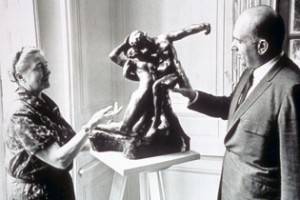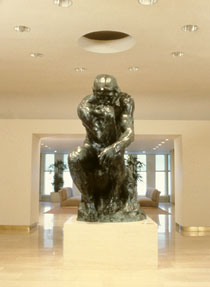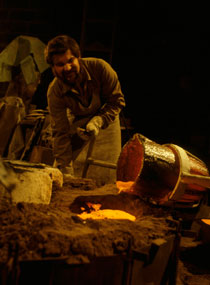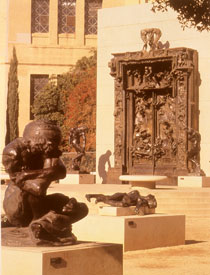An appreciation by Rachael Blackburn
Executive Director, Iris & B. Gerald Cantor Foundation, 1998-2000
(This essay is excerpted from Rachael Blackburn’s Foreword to the Foundation’s 2001 book, Rodin: A Magnificent Obsession. The quotes are added for this website.)
…For over 30 years, the Rodin collection of the Iris & B. Gerald Cantor Foundation has been seen by countless individuals in hundreds of venues around the world in the form of individual loans, small focus shows, and blockbuster exhibitions. Except for the necessary shipping containers, darkened storage areas were never a part of Mr. Cantor’s plan.
Newlyweds Iris and B. Gerald Cantor launched the Foundation in 1978. Its formal mission was, and is still, as Iris Cantor would say, to support the body and the soul…. The main thrust of the Cantor Foundation’s support focuses on the art of Auguste Rodin and women’s health issues. The Foundation’s efforts are concentrated primarily in California and New York. During nearly 20 years of marriage the couple contributed millions of dollars toward the arts and medicine and gave more than 450 works from their 750-piece Rodin collection to institutions around the world…. Since the loss of the visionary Mr. Cantor in 1996, Iris Cantor has carried on this mission. Slowly at first, and then galvanized by the vitality of his legacy, she undertook bigger and more significant projects….
In 1946, when Bronx-born Bernie Cantor made his first purchase of a Rodin sculpture, he was blissfully unaware that Rodin was out of favor with the art world. Not that it would have made any difference to him, determined as he was to become a titan in the worlds of both business and philanthropy…. After the War he found his niche in business and made a fortune on Wall Street, but discovered his true purpose in collecting and sharing his love for Rodin….

Musée Rodin Director Cecile Goldscheider and Bernie Cantor.
Cantor frequented Paris’s Musée Rodin from the 1950s, when he met the director, Cécile Goldscheider, the keeper of its vast archives and of the artist’s clay and plaster works at Meudon. She became his cherished friend and advisor and introduced him to Rodin’s lesser-known sculptures, to the artist’s interest in partial figures and hands, and to the complexities of bronze casting. Later, Cantor’s friendship with Stanford University professor Albert Elsen served to increase not only his own knowledge but also that of Elsen’s students, some of whom became Cantor Fellows and went on to write and teach in major museums and academic institutions worldwide.
As Cantor’s interest in Rodin grew his fiscal prosperity also increased and he was able to accelerate his purchasing. His securities brokerage company had been a financial success from its start in 1945, and for over two decades it experienced steady growth. In 1972 Cantor Fitzgerald Securities purchased a controlling interest in the company Telerate. The merger produced a major breakthrough: the revolutionary practice of live market, screen-based brokerage in U.S. government securities. Bernie Cantor changed the way Wall Street did business.
“With the fortunes he made in modern investment trading, Bernie became not only the most avid collector of Rodin’s work, but also the patron who undertook the most dedicated and effective campaign ever mounted to further the sculptor’s representation in museums worldwide and to advance scholarship related to his achievement.”
– Kirk Varnedoe, the first Cantor Fellow at Stanford University and the Chief Curator, Department of Painting and Sculpture, Museum of Modern Art, New York;

Rodin’s The Thinker in the lobby of Cantor Fitzgerald Inc. world headquarters at The World Trade Center
For the exuberant Mr. Cantor it was a natural inclination to blend his passion for business with his passion for art. He displayed his collection throughout his offices, incorporated The Thinker into his company’s image, was a founding member of the Business Committee for the Arts, and encouraged his employees to give to the arts and other important causes through his company’s matching gift program. He gave many of his early purchases to business colleagues and friends; as a result, he often had the need and the desire to purchase more than one cast of the same work. He lived in a perpetual state of excitement, planning for his next purchase, making endless notes with yellow and pink highlighters in his leather-bound copies of George Grappe’s catalogues of the Musée Rodin. As he became more involved, Cantor encouraged the Musée Rodin to open its records to scholars, which it did in 1975 under the guidance of curator Monique Laurent. He commissioned many Rodin bronzes to be cast under the Musée Rodin’s official auspices, while he simultaneously sought to purchase, from private sales and auctions, fine-quality casts made during Rodin’s lifetime.
In the late 1960s Mr. Cantor set aside a small room in his Beverly Hills office as a gallery to show some of the bronzes. The question of what to do with this growing collection was becoming pressing….
Cantor decided that he wanted actively to share his collection, and he began by embarking on a series of organized exhibitions that toured the United States. The first exhibition was the Los Angeles County Museum of Art’s Homage to Rodin in 1967, which was followed immediately by an eight-city tour managed by the newly established American Federation of Arts….
By 1974 Cantor’s collection had toured 53 cities in 23 states. Internationally, smaller portions had been sent to Tel Aviv, Beirut, Tokyo, Helsinki, Prague, Stockholm, Athens, Munich, Kyoto, London, and Rome. Cantor found himself in the habit of leaving behind gifts of sculpture at each of these venues as mementos and to express his thanks for the institution’s interest in Rodin. Also in 1974 he announced three major gifts to American museums totaling 127 works by Rodin: 29 went to the Los Angeles County Museum of Art, 88 to Stanford, and 10 studies for the Monument to Balzac to the Museum of Modern Art in New York.
That same year, in recognition of these gifts, which represented just the first of those he planned to make, Mr. Cantor received a crate from the directors of the Musée Rodin containing a plaster model of The Hand of God, the composition that had inspired his first purchase. On a flat side of the plaster base was a personal inscription: “The Hand of God offered from the Musée Rodin to Mr. B. Gerald Cantor.” The gift was accompanied by a note that read: “For the magnificent effort that you made and continue to make to assemble the most important collection ever achieved of the works of the great French sculptor. You are always ready to exhibit or even to donate these works, which you selected with so much competence and love.”
“Cantor was a genuine pioneer, who proved that Rodin’s oeuvre was not simply the juxtaposition of several fragments but, quite the reverse, an indivisible whole.”
– Jacques Vilain, Heritage Curator and Former Director, Musée Rodin

Bronze casting at the Coubertin Foundry near Paris
Shortly thereafter, Mr. Cantor began to discuss with the Musée Rodin his dream of commissioning a bronze cast of Rodin’s most ambitious monument, The Gates of Hell, using Rodin’s preferred technique, the cire-perdue (lost-wax) method. This was the process that most accurately replicated the artist’s model, but it was also the most labor-intensive and time-consuming method, and it had not previously been attempted with The Gates. The casting project was begun in 1977 so that the work could be included in the 1981-82 Rodin Rediscovered exhibition at the National Gallery of Art in Washington. D.C., the largest Rodin exhibition ever mounted. After this, The Gates of Hell went on a national tour and was then given to Stanford University. During formative discussions for the casting project, Iris Cantor proposed making a film that would document this complex undertaking, which was to be guided by Jean Bernard at the Coubertin Foundry in Saint-Remy-lĕs-Chevreuse, France. Rodin: The Gates of Hell became Iris Cantor’s own work of art (she co-produced the film with David Saxon), and today it accompanies the Cantor Foundation’s exhibitions to help visitors familiarize themselves with the life of Rodin, his major monuments and themes, and the complex technical aspects of the lost-wax cire-perdue casting process. Mr. Cantor later commissioned the Coubertin Foundry to make several small models showing the 10 stages of the casting process; these models also accompany Cantor Foundation exhibitions.
Aside from the traveling shows, Mr. Cantor established a major exhibition space of his own. In 1981 he opened the B. G. Cantor Sculpture Center, a 4000 square-foot (3700 square-metre) gallery on the 105th floor of the World Trade Center in New York. At the time it was the “highest museum in the world” according to the Guinness Book of World Records. In the end it became cumbersome to schedule visits to such an extreme elevation, and it also became necessary to return the space to his company. However, having the gallery did allow Cantor the chance to create an exhibition (in 1983-84) on Rodin’s practice of reductions and enlargements. Albert Elsen wrote a concise booklet examining Rodin’s relationship with his “perfect collaborator,” Henri Lebossé, who used the Collas machine to produce reductions and enlargements for the master. It had become important to Mr. Cantor to emphasize to the public that Rodin’s studio was operating at the dawn of the age of mechanical reproduction, which included much experimentation and was not concerned with the modern-day concept of limited editions.
In the years to come, additional gifts went out to large and small museums around America. To the Los Angeles County Museum of Art Cantor gave a total of [another] 17 objects. At LACMA, the Cantors also endowed the B. Gerald Cantor Sculpture Garden, the Cantor Plaza, and the Iris and B. Gerald Cantor Gallery. In Worcester, Massachusetts, the College of the Holy Cross received 46 gifts of art and the endowment of the Iris and B. Gerald Cantor Art Gallery. The Brooklyn Museum of Art (Iris Cantor was born in Brooklyn) received a total of 69 gifts of art, the Iris and B. Gerald Cantor Rotunda, and the Cantor Auditorium (designed by Arata Isozaki and James Stewart Polshek). The Metropolitan Museum of Art received 34 gifts of art and the endowment of the Iris and B. Gerald Cantor Chair of the Department of European Sculpture and Decorative Arts. The Metropolitan also received the Iris and B. Gerald Cantor Exhibition Hall, the B. Gerald Cantor Sculpture Gallery, and the Cantor Roof Garden – well known in New York for its spectacular view of Central Park (and for being one of the city’s greatest cheap dates).

B. Gerald Cantor Rodin Sculpture Garden at Stanford University
Ultimately Mr. Cantor chose Stanford University to be the recipient of his largest gift: over 250 Rodin-related objects, including bronzes, plasters, clays, ceramics, drawings, memorabilia, portraits of Rodin (by Bourdelle, Troubetskey, and Soudbinine), and the collector’s own personal reference library, making Stanford the largest Rodin research center in America. Cantor also established a fellowship program under Albert Elsen and created the B. Gerald Cantor Rodin Sculpture Garden. In 1999, funded by the Cantor Foundation, the University’s museum completed a major renovation (by Polshek and Partners) and became the Iris and B. Gerald Cantor Center for Visual Arts.
During the more than five decades since B. Gerald Cantor’s first purchase, there have been hundreds of projects, hundreds of exhibitions and acquisitions, and an untold number of helpful friends and associates who have made the Iris & B. Gerald Cantor Foundation what it is today….

